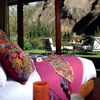|
|
|
|
|
|
|
|
|
Sacred Valley
|
|
 |
|
Sacred Valley is home to some of the finest Inca sites in all of Peru, to local markets packed with colourful
folk art and crafts, and to villages unchanged for centuries. The Valley is fed by numerous rivers which
descend through adjoining valleys and gorges, and contains numerous archaeological remains and villages.
The valley was appreciated by the Incas due to its special geographical and climatic qualities. It was one of
the empire's main points for the extraction of natural wealth, and the best place for maize production in Peru.
The Sacred Valley is generally understood to include everything between Písac and Ollantaytambo, parallel to
the Urubamba River, or Vilcanota River or Wilcamayu, as this Sacred river is called when passing through the
valley. Písac is a village in the Sacred Valley on the Urubamba River. The village is well-known for its market
every Sunday, Tuesday, and Thursday, but note it is open every day of the week.
Known as ‘the
land of the rainbow’ for the frequent rainbow citings in the area, Chinchero today is known for its outstanding
textiles and agricultural fair held on Sundays. This small town is located about 30km from Cuzco at a plateau
of 12,400 feet, part way between the highlands and the Sacred Valley. On Sundays only, campesinos from
surrounding villages set up a barter market, or mercado de treque, which is an ancient Peruvian custom and
an interesting example of the informal economies upon which highlanders depend. The local community
remains quite traditional, living in an old pre-hispanic settlement and maintaining the Quechuan traditions and
attire. It is said that Inca Tupac Yupanqui chose Chinchero as his place of residence. The palaces were later
burned down as a means of keeping the invading Spaniards at bay. The main plaza is outstanding with large
Inca walls and a beautiful colonial church. The Incan terraces, although not as spectacular as those of
Ollantaytambo, provide beautiful landscape to this charming village. The city of Ollantaytambo is best known
for its ruins, and for the spot where the Inca emperor Manco Inca was able to defeat the Spanish in a set-
piece battle. The finely cut rocks and plantation terraces were very large obstacles for the Conquistadors to
surpass, and the fortress was also used by Manco to conduct successful attacks on Francisco Pizarro and
other Conquistadors who were based in Lima. The site was built just as the Spaniards arrived and evidence of
how it was constructed is still visible. After admiring the site's magnificent past, stroll through the quaint
streets of today’s town.
|
|
|
|
|
|
 |
|
|
|
|
|
|
|
|
|
|

|
Aranwa
Aranwa Sacred Valley Hotel & Wellness is built on a seventeenth century colonial hacienda by the Vilcanota River, just o...
| |
|

|
Hotel Rio Sagrado
In the Sacred Valley of the Incas, close to the Inca capital of Cusco and below the ancient sacred city of Machu Picchu ...
| |
|
|

|
Sol y Luna
Sol y Luna has grown from a dream that Franz and Petit had more than 14 years ago: to establish themselves in the Sacred...
| |
|
|
|
|
|
|
|
|
|
|
|
|
|
|
|
|
|